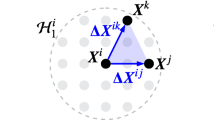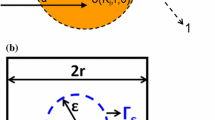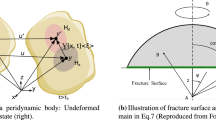Abstract
Peridynamic formulations of the mean stress and incubation time fracture models are discussed in the paper. Contemporary fracture simulations using the peridynamic theory often rely on critical bond stretch fracture criterion which is known to operate similar to energy-based fracture models. The energy-based fracture criteria—both in classical Griffith’s and Irwin’s form—are known to be powerful tools for fracture simulations and analysis. However, a number of experimentally observed dynamic fracture effects cannot be captured by these models, e.g. rate sensitivity of the material toughness. Thus, coupling of peridynamic approach with alternative stress-based fracture models would possibly broaden the peridynamics applicability. Here implementation technique of the aforementioned fracture model is discussed and its results for the case of a dynamically propagating crack with relatively low velocity due to quasistatic load appear to be in good agreement with the classical energy release rate approach.









Similar content being viewed by others
References
Griffith, A.A.: VI. The phenomena of rupture and flow in solids. Philos. Trans. R. Soc. Lond. Ser. A, Contain. Pap. Math. Phys. Character 221(582–593), 163–198 (1921)
Kashtanov, A., Petrov, Yu.V.: Fractal models in fracture mechanics. Int. J. Fract. 128, 271–276 (2004)
Ma, C.C., Freund, L.B.: The extent of the stress intensity factor field during crack growth under dynamic loading conditions. ASME J. Appl. Mech. 53, 303–310 (1986). https://doi.org/10.1115/1.3171756
Ravi-Chandar, K., Knauss, W.G.: An experimental investigation into dynamic fracture: III. On steady-state crack propagation and crack branching. Int. J. Fract. 26(2), 141–154 (1984)
Kalthoff, J.F.: On some current problems in Experimental Fracture Dynamics, pp. 11–25. California Institute of Technology, Workshop on Dynamic Fracture (1983)
Petrov, Y.V., Utkin, A.A.: Dependence of the dynamic strength on loading rate. Sov. Mater. Sci. 25(2), 153–156 (1989). https://doi.org/10.1007/BF00780499
Petrov, Y.V., Morozov, N.F.: On the modeling of fracture of brittle solids. J. Appl. Mech. 61, 710–712 (1994). https://doi.org/10.1115/1.2901518
Silling, S.A., Askari, E.: A meshfree method based on the peridynamic model of solid mechanics. Comput. Struct. 83(17–18), 1526–1535 (2005)
Ignatiev, M.O., Petrov, Y.V., Kazarinov, N.A.: Simulation of dynamic crack initiation based on the peridynamic numerical model and the incubation time criterion. Tech. Phys. 66(3), 422–425 (2021)
Ignatev, M., Kazarinov, N., Petrov, Yu.: Peridynamic modelling of the dynamic crack initiation. Procedia Struct. Integr. 28C, 1657–1661 (2020)
Parks, M.L., Littlewood, D.J., Mitchell, J.A., Silling, S.A.: Peridigm Users’ Guide, Tech. Report SAND2012-7800, Sandia National Laboratories (2012)
Silling, S.A.: Reformulation of elasticity theory for discontinuities and long-range forces. J. Mech. Phys. Solids 48(1), 175–209 (2000)
Silling, S.A., et al.: Peridynamic states and constitutive modeling. J. Elast. 88(2), 151–184 (2007)
Madenci, E., Oterkus, E.: Peridynamic Theory and its Applications. Springer, New York (2014)
Bobaru, F., Foster, J.T., Geubelle, P.H., Silling, S.A. (eds.): Handbook of Peridynamic Modeling. CRC Press (2016)
Oterkus, E., Oterkus, S., Madenci, E. (eds.): Peridynamic Modeling, Numerical Techniques, and Applications. Elsevier (2021)
Dell’Isola, F., Andreaus, U., Placidi, L.: At the origins and in the vanguard of peridynamics, non-local and higher-gradient continuum mechanics: an underestimated and still topical contribution of Gabrio Piola. Math. Mech. Solids 20(8), 887–928 (2015)
Dell’Isola, F., Della, Corte A., Giorgio, I.: Higher-gradient continua: The legacy of Piola, Mindlin, Sedov and Toupin and some future research perspectives. Math. Mech. Solids 22(4), 852–872 (2017)
Marconi, V.I., Jagla, E.A.: Diffuse interface approach to brittle fracture. Phys. Rev. E 71, 036110 (2005)
Randles, P., Libersky, L.: Recent improvements in SPH modeling of hypervelocity impact. Int. J. Impact Eng. 20, 525–532 (1997)
Placidi, E.L., Barchiesi, E., Misra, A., Timofeev, D.: Micromechanics-based elasto-plastic-damage energy formulation for strain gradient solids with granular microstructure. Contin. Mech. Thermodyn. 33, 2213–2241 (2021)
Timofeev, D., Barchiesi, E., Misra, A., Placidi, L.: Hemivariational continuum approach for granular solids with damage-induced anisotropy evolution. Math. Mech. Solids 26(5), 738–770 (2021). https://doi.org/10.1177/1081286520968149
Neuber, H.: Kerbspannungslehre (Notch Stresses). Verlag von Julius Springer, Berlin (1937)
Novozhilov, V.V.: On a necessary and sufficient criterion for brittle strength: PMM vol. 33, no. 2, 1969, 212–222. J. Appl. Math. Mech. 33(2), 201–210 (1969)
Petrov, Y.V.: On “quantum” nature of dynamic fracture of brittle solids. Dokl. Akad. Nauk. USSR 321, 66–68 (1991)
Maksimov, V., Barchiesi, E., Misra, A., Placidi, L., and Timofeev, D.: Two-dimensional analysis of size effects in strain gradient granular solids with damage-induced anisotropy evolution. J. Eng. Mech. 04021098-1 (2021)
De Angelo, M., Spagnuolo, M., D’Annibale, F., et al.: The macroscopic behavior of pantographic sheets depends mainly on their microstructure: experimental evidence and qualitative analysis of damage in metallic specimens. Contin. Mech. Thermodyn. 31, 1181–1203 (2019). https://doi.org/10.1007/s00161-019-00757-3
dell’Isola, F., Seppecher, P., Alibert, J.J., et al.: Pantographic metamaterials: an example of mathematically driven design and of its technological challenges. Contin. Mech. Thermodyn. 31(4), 851–884 (2019). https://doi.org/10.1007/s00161-018-0689-8
Gruzdkov, A., Sitnikova, E., Morozov, N., Petrov, Y.: Thermal effect in dynamic yielding and fracture of metals and alloys. Math. Mech. Solids 14, 72–87 (2009). https://doi.org/10.1177/1081286508092603
Petrov, Y.V., Karihaloo, B.L., Bratov, V.V., Bragov, A.M.: Multi-scale dynamic fracture model for quasi-brittle materials. Int. J. Eng. Sci. 61, 3–9 (2009). https://doi.org/10.1016/j.ijengsci.2012.06.004
Bratov, V., Petrov, Y.: Application of incubation time approach to simulate dynamic crack propagation. Int. J. Fract. 146, 53–60 (2007). https://doi.org/10.1007/s10704-007-9135-9
Evstifeev, A., Kazarinov, N., Petrov, Yu.V., Witek, L., Bednarz, A.: Experimental and theoretical analysis of solid particle erosion of a steel compressor blade based on incubation time concept. Eng. Fail. Anal. 87, 15–21 (2018). https://doi.org/10.1016/j.engfailanal.2018.01.006
Hattori, G., Trevelyan, J., Coombs, W.M.: A non-ordinary state-based peridynamics framework for anisotropic materials. Comput. Methods Appl. Mech. Eng. 339, 416–442 (2018)
Stenström, C., Eriksson, K.: The J-contour integral in peridynamics via displacements. Int. J. Fract. 216(2), 173–183 (2019)
Ha, Y.D., Bobaru, F.: Studies of dynamic crack propagation and crack branching with peridynamics. Int. J. Fract. 162(1–2), 229–244 (2010)
Kazarinov, N., Bratov, V., Petrov, Y.V.: Simulation of dynamic crack propagation under quasistatic loading. In: Applied Mechanics and Materials, vol. 532, pp. 337–341. Trans Tech Publications Ltd (2014)
Fineberg, J., Gross, S.P., Marder, M., Swinney, H.L.: Instability in the propagation of fast cracks. Phys. Rev. B 45(10), 5146 (1992)
Le, Q.V., Bobaru, F.: Surface corrections for peridynamic models in elasticity and fracture. Comput. Mech. 61(4), 499–518 (2018)
Acknowledgements
Author information
Authors and Affiliations
Corresponding author
Additional information
Communicated by Andreas Öchsner.
Publisher's Note
Springer Nature remains neutral with regard to jurisdictional claims in published maps and institutional affiliations.
Rights and permissions
Springer Nature or its licensor (e.g. a society or other partner) holds exclusive rights to this article under a publishing agreement with the author(s) or other rightsholder(s); author self-archiving of the accepted manuscript version of this article is solely governed by the terms of such publishing agreement and applicable law.
About this article
Cite this article
Ignatiev, M.O., Petrov, Y.V., Kazarinov, N.A. et al. Peridynamic formulation of the mean stress and incubation time fracture criteria and its correspondence to the classical Griffith’s approach. Continuum Mech. Thermodyn. 35, 1523–1534 (2023). https://doi.org/10.1007/s00161-022-01159-8
Received:
Accepted:
Published:
Issue Date:
DOI: https://doi.org/10.1007/s00161-022-01159-8




